
Stuart R. Stock
Research professor of cell and molecular biology, Feinberg School of Medicine
Who is she, this little mummy girl? Northwestern University scientists and students are working to unravel some of her mysteries, including how her body was prepared 1,900 years ago in Egypt, what items she may have been buried with, the quality of her bones and what material is present in her brain cavity.
As part of a comprehensive scientific investigation, the mummy traveled from Evanston to Argonne National Laboratory on Nov. 27 for an all-day X-ray scattering experiment. It was the first study of its kind performed on a human mummy.
“This is a unique experiment, a 3-D puzzle,” said Stuart R. Stock, research professor of cell and molecular biology at Northwestern University Feinberg School of Medicine, who led the synchrotron experiment. “We have some preliminary findings about the various materials, but it will take days before we tighten down the precise answers to our questions. We have confirmed that the shards in the brain cavity are likely solidified pitch, not a crystalline material.”
The Roman-Egyptian mummy -- which resides at the Garrett-Evangelical Theological Seminary on Northwestern’s Evanston campus -- is one of only approximately 100 portrait mummies in the world. These mummies have an extremely lifelike painting of the deceased individual incorporated into the mummy wrappings and placed directly over the person’s face. The Romans introduced to Egypt these 2-D portraits of the dead after almost 3,000 years of idealized 3-D images. (Think King Tut).
Just over three feet long, the little girl’s body is swaddled in a copious amount of linen. The outermost wrappings have been arranged in an ornate geometric pattern of overlapping rhomboids and also serve to frame the portrait. The face, painted with beeswax and pigment, gazes serenely outward, her dark hair gathered at the back. She is wearing a crimson tunic and gold jewelry.
The study of this rare archeological object, owned by Garrett-Evangelical, is part of an interdisciplinary class at Northwestern focused, in part, on filling out the contextual story of where this mummy came from and who she was.
Thirteen materials science and humanities students are examining the materials and methods used to create both this intact portrait mummy and a well-preserved collection of Roman-Egyptian mummy portraits for an upcoming exhibition at Northwestern’s Block Museum of Art. Earlier in the quarter, the class traveled to California to study the portraits at the Phoebe A. Hearst Museum of Anthropology at the University of California, Berkeley, which will loan the portraits to the Block Museum. (Unlike the Garrett mummy, each of these portraits has been separated from its mummy.)
The students already have discovered that the Garrett mummy’s portrait was put together in a very different way from the Hearst Museum portraits and likely is from a different workshop. These findings and others yet to come, including results from the synchrotron X-ray study of the Garrett mummy, will culminate in the Block Museum exhibition, “Paint the Eyes Softer: Mummy Portraits from Roman Egypt.”
“Intact portrait mummies are exceedingly rare, and to have one here on campus was revelatory for the class and exhibition,” said Marc Walton, a research professor of materials science and engineering at Northwestern’s McCormick School of Engineering. He is teaching the fall quarter class with Taco Terpstra, assistant professor of classics and history at the Weinberg College of Arts and Sciences.
The “Paint the Eyes Softer” exhibition will reunite ancient neighbors: the girl portrait mummy is from the site of Hawara, a site close to Tebtunis, where the Hearst Museum’s mummy portraits are originally from. The Hawara, or Garrett, mummy is believed to be from a high-status family and was entombed in an underground chamber with four other mummies.
“This is a once-in-a-lifetime opportunity for our undergraduate students -- and for me -- to work at understanding the whole object that is this girl mummy,” Walton said. “Today’s powerful analytical tools allow us to nondestructively do the archaeology scientists couldn’t do 100 years ago.”
The synchrotron experiment at Argonne is a modern-day version of 19th-century England’s “mummy unwrapping” parties, Walton said. The Northwestern team collaborated with scientists at Argonne and used the extremely brilliant high-energy synchrotron X-rays produced by Argonne’s Advanced Photon Source to probe the materials and objects inside the mummy, while leaving the mummy and her wrappings intact.
“From a medical research perspective, I am interested in what we can learn about her bone tissue,” Stock said. “We also are investigating a scarab-shaped object, her teeth and what look like wires near the mummy’s head and feet.”
Prior to its trip to Argonne, the mummy had a CT scan at Northwestern Memorial Hospital in August, also led by Stock. The scan gave the researchers a 3-D map of the structure of the mummy and enabled them to confirm the girl is 5 years old (give or take nine months).
At the Advanced Photon Source, Stock and his team shined the pencil-shaped X-ray beam (about twice the diameter of a human hair) on areas of high-density in the mummy that were identified by the CT scan. They now will use the X-ray diffraction patterns as “fingerprints” to identify each crystalline material. For example, is the black rounded object seen on the CT scan a gold object or a rock?
The findings from the synchrotron experiment, CT scan and other scientific analyses and studies of history conducted by the students will help researchers and historians better understand the context in which the Garrett mummy was excavated in 1911 as well as Roman-period mummification practices. Also, conservators will use the information to best preserve the mummy.
“We’re basically able to go back to an excavation that happened more than 100 years ago and reconstruct it with our contemporary analysis techniques,” Walton said. “All the information we find will help us enrich the entire historic context of this young girl mummy and the Roman period in Egypt.”
Jan. 13 to April 22, 2018
Block Museum of Art, Northwestern University
40 Arts Circle Drive, on the Evanston campus
Co-presented by the Block Museum of Art and McCormick School of Engineering, “Paint the Eyes Softer” brings to Northwestern a series of mummy portraits produced in Egypt during the Roman period, alongside a complete intact portrait mummy and other archeological finds from the Fayum region. Combining expertise from across the University -- including contributions from classics, art history, sound design, materials science, medicine, archeology, art history and molecular biology -- this groundbreaking installation explores how interdisciplinary partnerships can deliver new insights into ancient mysteries.
On view within the exhibition will be a series of rare Roman-Egyptian funerary portraits. Painted on wooden panels between the first and third centuries CE in Egypt, these visages of the dead were originally secured over the face of the deceased within the mummy wrappings. When these works were excavated at the beginning of the 20th century, they transformed the world with their immediacy, thought to reveal naturalistic individual likenesses of people who lived 2,000 years ago. Some of the earliest portraits in existence, these paintings offer viewers a face-to-face encounter with the past. The words on one sketch board still bear personal instructions to an artist of an earlier millennium: “(paint the) eyes softer,” it indicates in Greek.
The majority of the objects on view at the Block Museum, excavated from the site of Tebtunis (now Umm-el-Breigat, Egypt), are loans from the Phoebe A. Hearst Museum of Anthropology at the University of California, Berkeley. One of the largest collections of Roman portraits to have remained intact since excavation, they present a rare opportunity to study the material microhistory of painting tradition in a known context and to explore how ancient paintings were created.
The exhibition is organized by the Block Museum of Art at Northwestern University in collaboration with the McCormick School of Engineering, Weinberg College of Arts and Sciences and Feinberg School of Medicine.
Exhibition support for “Paint the Eyes Softer” is provided by the Barry and Mary Ann MacLean Fund for Art and Engineering, the Alumnae Continuing Education program funds of The Alumnae of Northwestern University, the Andrew W. Mellon Foundation and the Alice Kaplan Institute for the Humanities. Additional support is provided by Block Museum Science and Technology Fund, Alsdorf Gallery at the Block Museum Fund and the Mary and Leigh Block Endowment. Exhibition sound design is thanks to Stephan Moore and students in the Sound Cultures seminar, Northwestern School of Communication.
<iframe width="560" height="315" src="https://www.youtube.com/embed/wkxmhOG8D10" frameborder="0" allow="accelerometer; autoplay; encrypted-media; gyroscope; picture-in-picture" allowfullscreen></iframe>
The Block Museum of Art and the McCormick School of Engineering at Northwestern University delve into the art and science of ancient artifacts in the upcoming exhibition “Paint the Eyes Softer: Mummy Portraits from Roman Egypt,” opening Jan. 13 and running through April 22, 2018. The exhibition brings to the Block Museum a series of mummy portraits produced in Egypt during the Roman period, a young girl mummy with an intact portrait and other archeological finds from the Fayum region. Images courtesy of the Phoebe A. Hearst Museum of Anthropology and the Regents of the University of California.
View the "Paint the Eyes Softer" Exhibition images and captions
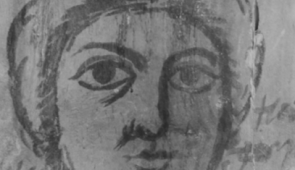
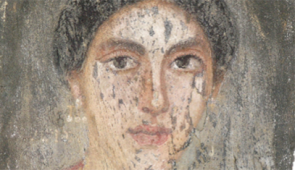
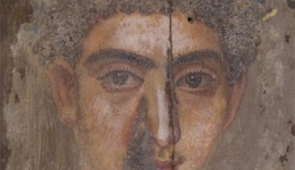
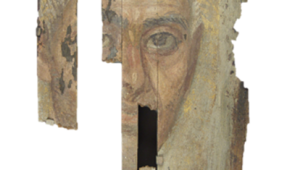
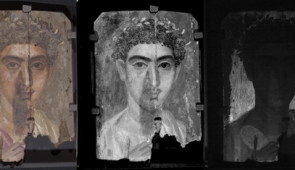
Housed permanently at the Styberg Library at Garrett-Evangelical Theological Seminary on Northwestern University's Evanston campus, the Hibbard mummy is currently on loan to Northwestern's Block Museum of Art for an exhibition entitled “Paint the Eyes Softer: Mummy Portraits from Roman Egypt.” The Hibbard mummy (also known as Hawara Portrait Mummy No. 4) is a portrait mummy of a young girl, approximately 5 years old. Lydia Beekman Hibbard received the Hibbard mummy in gratitude for her financial support of Sir Flinders Petrie’s excavations in a Roman cemetery in Hawara, Egypt, in 1911. She donated the mummy to Western Theological Seminary of Chicago in 1912 to be included in the Hibbard Egyptian Library. Western Theological Seminary then merged with Seabury Divinity School to become Seabury-Western Theological Seminary. In 2009, when Seabury-Western sold their buildings and property to Northwestern University, Garrett-Evangelical purchased Seabury-Western’s library collection, including the Hibbard mummy.
In fall of 2017, Northwestern undergraduate student researchers, under the guidance of instructors Marc Walton and Taco Terpstra, scientifically analyze a Roman-Egyptian period portrait mummy to collect data that will aid in the historical inquiry and contextualize its meaning in preparation for its exhibition at the Block Museum of Art, beginning in January. Images courtesy Block Museum of Art.
On Nov. 27, 2017, Stuart R. Stock, research professor of cell and molecular biology at Northwestern’s Feinberg School of Medicine, worked with Argonne National Laboratory technicians to conduct the first X-ray scattering experiment on a human mummy. The high-energy synchrotron X-rays produced by Argonne’s Advanced Photon Source probed inside the mummy to help identify materials and objects, while leaving the mummy and her wrappings intact. Photo credit Jim Prisching.
Prior to its Nov. 27 trip to Argonne National Laboratory, the mummy had a CT scan at Northwestern Memorial Hospital in August 2017. The scan gave researchers a 3-D map of the structure, revealing opaque areas meriting a closer look with the synchrotron experiment at Argonne. The CT scan also enabled them to confirm the girl is 5 years old (give or take nine months). Images courtesy of Northwestern University.

Research professor of cell and molecular biology, Feinberg School of Medicine

Assistant professor of classics and history, Weinberg College of Arts and Sciences

Curatorial associate for special projects, Block Museum of Art

Associate conservator, objects conservation department, The Art Institute of Chicago